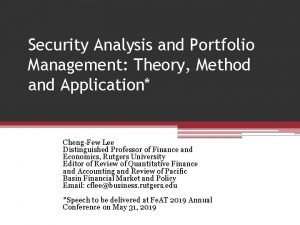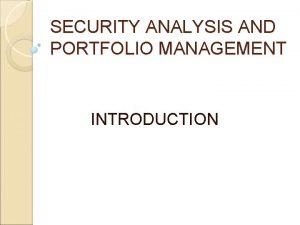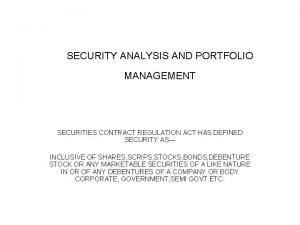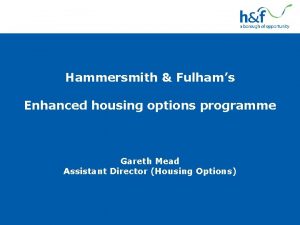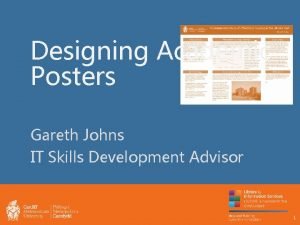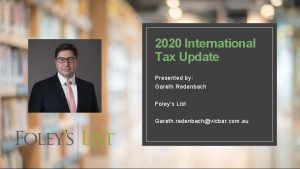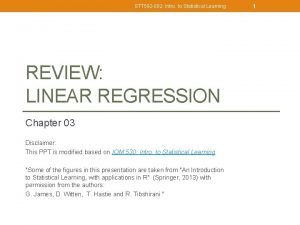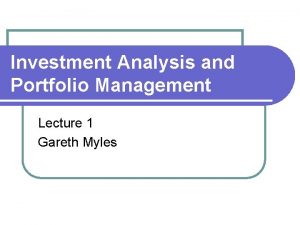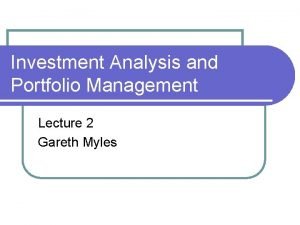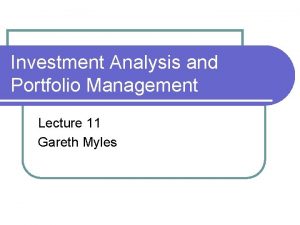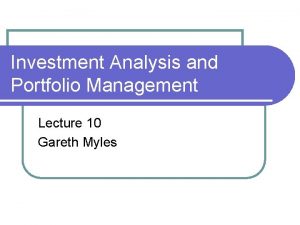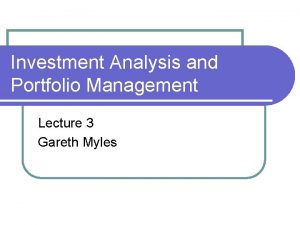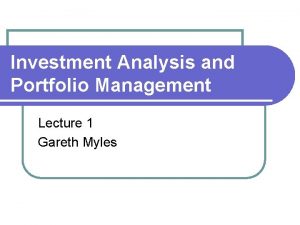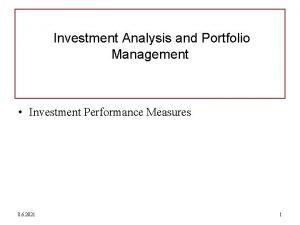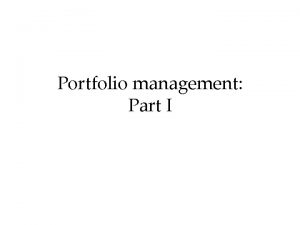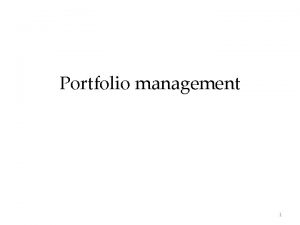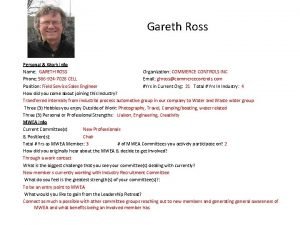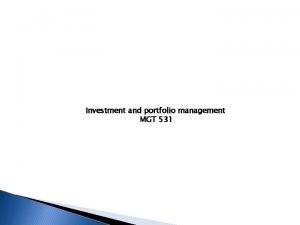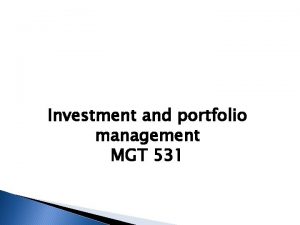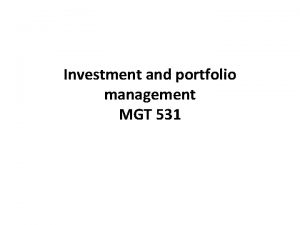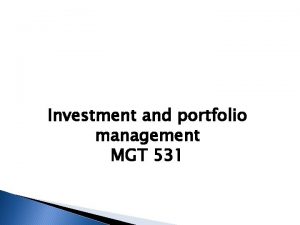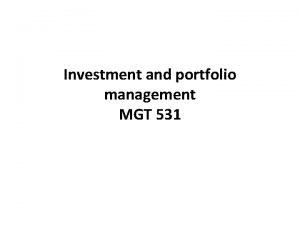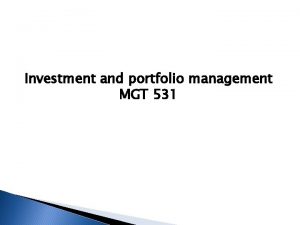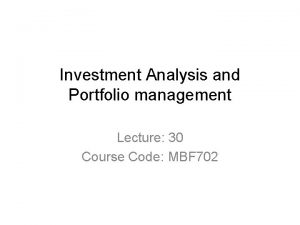Investment Analysis and Portfolio Management Lecture 6 Gareth





![Portfolio Variance l So N + (1/2)N[N – 1] = (1/2)N[N + 1] pieces Portfolio Variance l So N + (1/2)N[N – 1] = (1/2)N[N + 1] pieces](https://slidetodoc.com/presentation_image_h/7f85ac4311bada7212a14d3112ded36b/image-6.jpg)























- Slides: 29

Investment Analysis and Portfolio Management Lecture 6 Gareth Myles

Announcement l There is no lecture next week (Thursday 27 th February)

The Single-Index Model l Efficient frontier Shows achievable risk/return combinations l Permits selection of assets l l Can be constructed for any number of assets l Given expected returns, variances and covariances l Calculation is demanding in the information required

The Single-Index Model l More useful if information demand can be reduced l The single-index model is one way to do this l Imposes a statistical model of returns Simplifies construction of frontier l The model may (or may not) be accurate l l The reduced information demand is traded against accuracy

Portfolio Variance l The variance of a portfolio is given by This requires the knowledge of N variances and N[N – 1] covariances l But symmetry ( ) reduces this to (1/2)N[N – 1] covariances l
![Portfolio Variance l So N 12NN 1 12NN 1 pieces Portfolio Variance l So N + (1/2)N[N – 1] = (1/2)N[N + 1] pieces](https://slidetodoc.com/presentation_image_h/7f85ac4311bada7212a14d3112ded36b/image-6.jpg)
Portfolio Variance l So N + (1/2)N[N – 1] = (1/2)N[N + 1] pieces of information are required to compute the variance l Example l l If a portfolio is composed of all FT 100 shares then (1/2)N[N + 1] = 5050 This is not even an especially large portfolio

Portfolio Variance l Where can the information come from? l l 1. Data on financial performance (estimation) 2. From analysts (whose job it is to understand assets) But brokerages are typically organized into market sectors such as oil, electronics, retailers l This structure can inform about variances but not covariances between sectors l So there is a problem of implementation l

Model A possible solution is to relate the returns on assets to some underlying variable l Let the return on asset i be modeled by l = return on asset i, = return on index, = random error l Return is linearly related to return on the index l This model is imposed and may not capture the data l

Model Three assumptions are placed on this model l The expected error is zero: l l The error and the return on the index are uncorrelated: l The errors are uncorrelated between assets:

Model The model is estimated using data l Observe the return on the market and the return on the asset l Carry out linear regression to find line of best fit l

Example 10 British American Tobacco Barclays 8 20 6 10 4 0 -10 2 -5 0 -2 0 5 -10 0 -10 -5 5 10 -20 -4 -30 -6 -40 Monthly data on stock return and FTSE 100 return l Observe different scales on vertical axis l 10

Example 20 10 0 -10 -8 -6 -4 -2 0 -10 -20 -30 -40 2 4 6 8 10 BAT Barclays

Model l The estimated values are l With l l The estimation process ensures the average error is zero The value of is the gradient of the fitted line

Example 10 British American Tobacco Barclays 8 30 6 20 4 10 2 0 -10 -5 0 5 10 -5 0 -2 -20 -4 -30 -6 5 -10 -40 R 2 = 0. 6304 10

Example 30 20 10 BAT 0 -10 -8 -6 -4 -2 0 2 4 6 8 Barclays 10 Linear(BAT) -10 -20 -30 -40 Linear(Barclays)

Model l If the model is applied to all assets it need not follow that If the covariance of errors are non-zero this indicates the index is not the only explanatory factor l Some other factor or factors is correlated with (or “explains”) the observed returns l

Model l Note: l And l These observations permits a characterization of assets

Assets Types If then the asset is more volatile (or risky) than the market l This is termed an “aggressive” asset l ri r. I

Assets Types If then the asset is less volatile than the market l This is termed a “defensive” asset l

Risk For an individual asset l If then l

Risk l This can be written l So risk is composed of two parts: 1. market (or systematic) risk 2. unique (or unsystematic) risk

Return l Portfolio return

Return l Hence The portfolio has a value of beta l This also determines its risk l

Risk l Portfolio variance is

Risk l The final expression can also be written Consequence: now need to only know and , i = 1, . . . , N l For example, for FT 100 need to know 101 variances (reduced from 5050) l

Diversified Portfolio l A large portfolio that is evenly held l The non-systematic variance is l This tends to 0 as N tends to infinity, so only market risk is left

Diversified Portfolio l That is l tends to l l is undiversifiable market risk is diversifiable risk

Market Model A special case of the single-index model l The index is the market l l l The market model has two additional properties l l l The set of all assets that can be purchased Weighted-average beta = 1 Weighted-average alpha = 0 Issue: how is the market defined? l This is discussed for CAPM

Adjusting Beta l The value of beta for an asset can be calculated from observed data l This is the historic beta l There are two reasons why this value might be adjusted before being used Sampling l Fundamentals l
 Investment analysis and portfolio management notes for mba
Investment analysis and portfolio management notes for mba Scope of investment analysis and portfolio management
Scope of investment analysis and portfolio management Investment analysis and portfolio management course
Investment analysis and portfolio management course Investment analysis & portfolio management
Investment analysis & portfolio management Fixed investment and inventory investment
Fixed investment and inventory investment 01:640:244 lecture notes - lecture 15: plat, idah, farad
01:640:244 lecture notes - lecture 15: plat, idah, farad Security analysis and portfolio management project
Security analysis and portfolio management project Security analysis and portfolio management project
Security analysis and portfolio management project Importance of security analysis and portfolio management
Importance of security analysis and portfolio management Risk in security analysis and portfolio management
Risk in security analysis and portfolio management What is portfolio
What is portfolio Gareth redenbach
Gareth redenbach Gareth mead
Gareth mead Gareth bale meat
Gareth bale meat Gareth hynes
Gareth hynes Gareth price duke
Gareth price duke Gareth price duke
Gareth price duke Wjec criminology unit 3 answers
Wjec criminology unit 3 answers Gareth denyer
Gareth denyer Gareth johns
Gareth johns Gareth jones
Gareth jones Foogle transle
Foogle transle Dr gareth james
Dr gareth james The crocodile by gareth lancaster
The crocodile by gareth lancaster Gareth philips
Gareth philips Dr gareth hughes
Dr gareth hughes Gareth james pools
Gareth james pools Gareth redenbach
Gareth redenbach Gareth phillips afdb
Gareth phillips afdb 002
002






